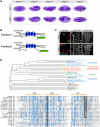Pasiflora proteins are novel core components of the septate junction
- PMID: 26329602
- PMCID: PMC4582180
- DOI: 10.1242/dev.119412
Pasiflora proteins are novel core components of the septate junction
Abstract
Epithelial sheets play essential roles as selective barriers insulating the body from the environment and establishing distinct chemical compartments within it. In invertebrate epithelia, septate junctions (SJs) consist of large multi-protein complexes that localize at the apicolateral membrane and mediate barrier function. Here, we report the identification of two novel SJ components, Pasiflora1 and Pasiflora2, through a genome-wide glial RNAi screen in Drosophila. Pasiflora mutants show permeable blood-brain and tracheal barriers, overelongated tracheal tubes and mislocalization of SJ proteins. Consistent with the observed phenotypes, the genes are co-expressed in embryonic epithelia and glia and are required cell-autonomously to exert their function. Pasiflora1 and Pasiflora2 belong to a previously uncharacterized family of tetraspan membrane proteins conserved across the protostome-deuterostome divide. Both proteins localize at SJs and their apicolateral membrane accumulation depends on other complex components. In fluorescence recovery after photobleaching experiments we demonstrate that pasiflora proteins are core SJ components as they are required for complex formation and exhibit restricted mobility within the membrane of wild-type epithelial cells, but rapid diffusion in cells with disrupted SJs. Taken together, our results show that Pasiflora1 and Pasiflora2 are novel integral components of the SJ and implicate a new family of tetraspan proteins in the function of these ancient and crucial cell junctions.
Keywords: Blood-brain barrier; Drosophila; Epithelia; Septate junction; Trachea.
© 2015. Published by The Company of Biologists Ltd.
Figures







Similar articles
-
The ESCRT machinery regulates retromer-dependent transcytosis of septate junction components in Drosophila.Elife. 2020 Dec 30;9:e61866. doi: 10.7554/eLife.61866. Elife. 2020. PMID: 33377869 Free PMC article.
-
The Ly6 protein coiled is required for septate junction and blood brain barrier organisation in Drosophila.PLoS One. 2011 Mar 15;6(3):e17763. doi: 10.1371/journal.pone.0017763. PLoS One. 2011. PMID: 21423573 Free PMC article.
-
The claudin-like megatrachea is essential in septate junctions for the epithelial barrier function in Drosophila.Dev Cell. 2003 Oct;5(4):611-20. doi: 10.1016/s1534-5807(03)00275-2. Dev Cell. 2003. PMID: 14536062
-
Molecular organization and function of invertebrate occluding junctions.Semin Cell Dev Biol. 2014 Dec;36:186-93. doi: 10.1016/j.semcdb.2014.09.009. Epub 2014 Sep 17. Semin Cell Dev Biol. 2014. PMID: 25239398 Review.
-
The Drosophila septate junctions beyond barrier function: Review of the literature, prediction of human orthologs of the SJ-related proteins and identification of protein domain families.Acta Physiol (Oxf). 2021 Jan;231(1):e13527. doi: 10.1111/apha.13527. Epub 2020 Aug 5. Acta Physiol (Oxf). 2021. PMID: 32603029 Review.
Cited by
-
The cAMP effector PKA mediates Moody GPCR signaling in Drosophila blood-brain barrier formation and maturation.Elife. 2021 Aug 12;10:e68275. doi: 10.7554/eLife.68275. Elife. 2021. PMID: 34382936 Free PMC article.
-
Single-Molecule Imaging in Living Drosophila Embryos with Reflected Light-Sheet Microscopy.Biophys J. 2016 Feb 23;110(4):939-46. doi: 10.1016/j.bpj.2015.12.035. Biophys J. 2016. PMID: 26910430 Free PMC article.
-
The Drosophila tricellular junction protein Gliotactin regulates its own mRNA levels through BMP-mediated induction of miR-184.J Cell Sci. 2016 Apr 1;129(7):1477-89. doi: 10.1242/jcs.178608. Epub 2016 Feb 16. J Cell Sci. 2016. PMID: 26906422 Free PMC article.
-
Expanding the Junction: New Insights into Non-Occluding Roles for Septate Junction Proteins during Development.J Dev Biol. 2021 Mar 21;9(1):11. doi: 10.3390/jdb9010011. J Dev Biol. 2021. PMID: 33801162 Free PMC article. Review.
-
The septate junction protein Mesh is required for epithelial morphogenesis, ion transport, and paracellular permeability in the Drosophila Malpighian tubule.Am J Physiol Cell Physiol. 2020 Mar 1;318(3):C675-C694. doi: 10.1152/ajpcell.00492.2019. Epub 2020 Jan 8. Am J Physiol Cell Physiol. 2020. PMID: 31913700 Free PMC article.
References
-
- Baumgartner S., Littleton J. T., Broadie K., Bhat M. A., Harbecke R., Lengyel J. A., Chiquet-Ehrismann R., Prokop A. and Bellen H. J. (1996). A Drosophila neurexin is required for septate junction and blood-nerve barrier formation and function. Cell 87, 1059-1068. 10.1016/S0092-8674(00)81800-0 - DOI - PubMed
-
- Cording J., Berg J., Kading N., Bellmann C., Tscheik C., Westphal J. K., Milatz S., Gunzel D., Wolburg H., Piontek J., et al. (2013). In tight junctions, claudins regulate the interactions between occludin, tricellulin and marvelD3, which, inversely, modulate claudin oligomerization. J. Cell Sci. 126, 554-564. 10.1242/jcs.114306 - DOI - PubMed
Publication types
MeSH terms
Substances
Grants and funding
LinkOut - more resources
Full Text Sources
Other Literature Sources
Molecular Biology Databases

